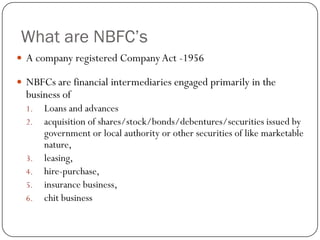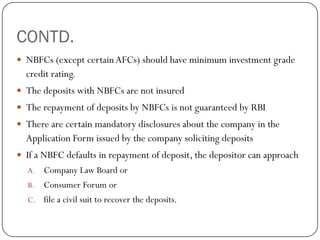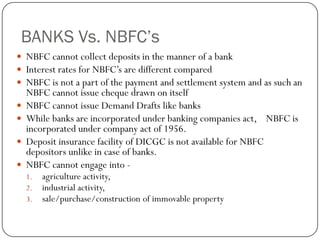Bank and nbfc’s
- 1. NBFC’s and BANK SERVICE OPERATIONS MANAGEMENT
- 2. What are NBFC’s A company registered Company Act -1956 NBFCs are financial intermediaries engaged primarily in the business of 1. Loans and advances 2. acquisition of shares/stock/bonds/debentures/securities issued by government or local authority or other securities of like marketable nature, 3. leasing, 4. hire-purchase, 5. insurance business, 6. chit business
- 3. Different Types Of NBFC’s NBFC TRADITIONAL MODERN APPROACH OF APPROACH OF RESIDUARY CLASSIFICATIO CLASSIFICATIO NBFC N N Equipment Hire Purchase Asset Finance Company Loan Company Leasing Co. Company Investment Investment Loan Company Company Company
- 4. Features of NBFC’s Registration with RBI is mandatory All the NBFC are not entitled to accept public deposits NBFC can accept public deposit for a minimum period of 12 months and maximum of 60 months They cannot accept deposits repayable on demand NBFCs cannot offer interest rates higher than the ceiling rate prescribed by RBI from time to time NBFCs cannot offer gifts/incentives or any other additional benefit to the depositors
- 5. CONTD. NBFCs (except certain AFCs) should have minimum investment grade credit rating. The deposits with NBFCs are not insured The repayment of deposits by NBFCs is not guaranteed by RBI There are certain mandatory disclosures about the company in the Application Form issued by the company soliciting deposits If a NBFC defaults in repayment of deposit, the depositor can approach A. Company Law Board or B. Consumer Forum or C. file a civil suit to recover the deposits.
- 6. All About Indian Banks: The basic function of a bank is to accept deposits from public for the purpose of lending. Directed under the RBI guidelines. Around 26 nationalized bank in India. 13 old private sector banks. 7 new age private sector banks. Around 30 foreign banks.
- 7. Functions
- 8. Primary Functions Accepting Deposits The bank collects deposits from the public. These deposits can be of different types, such as :- 1. Saving Deposits 2. Fixed Deposits 3. Current Deposits 4. Recurring Deposits
- 9. CONTD. Granting of Loans and Advances The bank advances loans to the business community and other members of the public. The rate charged is higher than what it pays on deposits. The difference in the interest rates (lending rate and the deposit rate) is its profit. The types of bank loans and advances are :- 1. Overdraft 2. Cash Credits 3. Loans 4. Discounting of Bill of Exchange
- 10. Secondary functions Agency Functions The bank acts as an agent of its customers. The bank performs a number of agency functions which includes :- Transfer of Funds 1. Collection of Cheque 2. Periodic Payments 3. Portfolio Management 4. Periodic Collections 5. Other Agency Function
- 11. CONTD. General Utility Functions The bank also performs general utility functions, such as :- Issue of Drafts, Letter of Credits, etc. 1. Locker Facility 2. Underwriting of Shares 3. Dealing in Foreign Exchange 4. Project Reports 5. Social Welfare Programs 6. Other Utility Functions
- 12. Why NBFC’s? Only 34% of Indian individuals have access to banks. Banks have a lot of constraints in lending. Conditions for getting a loan. Proximity of financial services. Size of loans. Higher risk taking ability. Innovative business model. Expert skills. Relationship with customers. Single product and dedicated business.
- 13. Some examples In infrastructure financing credit risk evaluation is the main job. For collecting the dues they use human resources and pay them lower than what banks pay. Banks lack here. In truck financing majority of the truck drivers don’t have proper papers to get the loans. Many SME’s in India are like truck drivers. In home finance, housing finance companies (HFC) flourish with higher focus and better customer service. NBFC’s are the top priority in the above sectors.
- 14. BANKS Vs. NBFC’s NBFC cannot collect deposits in the manner of a bank Interest rates for NBFC’s are different compared NBFC is not a part of the payment and settlement system and as such an NBFC cannot issue cheque drawn on itself NBFC cannot issue Demand Drafts like banks While banks are incorporated under banking companies act, NBFC is incorporated under company act of 1956. Deposit insurance facility of DICGC is not available for NBFC depositors unlike in case of banks. NBFC cannot engage into - 1. agriculture activity, 2. industrial activity, 3. sale/purchase/construction of immovable property
- 15. THANK YOU RAHUL H - 73 GANAPATHY S - 85














